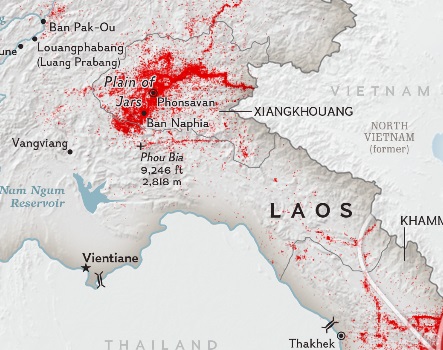The United States and its allies dropped over two million tons of bombs on Laos during the Vietnam War. That's a ton for every citizen of the country (at the time) and equal to a planeload every 8 minutes for 9 years. National Geographic's August issue has a great article and map of the bombing sites.
Bombings were concentrated on the Plain of Jars in the north and the Hi Chi Minh Trail in the south, a supply route between North and South Vietnam. Here is a detail showing the Plain of Jars.
The interactive map has a time slider so you can see the numbers grow over the war period (1964-1973) The article discusses the opportunities and hazards all this scrap metal presents. An unknown, but very high percentage of these bombs did not explode on impact and are still out there, waiting to explode. In 2012 15 Laotians were killed and another 41 injured by live ordnance. The U.S. government has put a relatively small amount of money towards the removal of unexploded ordnance. Laos could use some more help cleaning up after us.
For more information see National Geographic.
If you click on the interactive map, you can download the text overlay image which gives you a map of Laos in isolation - no bombs, no neighbors.
The interactive map has a time slider so you can see the numbers grow over the war period (1964-1973) The article discusses the opportunities and hazards all this scrap metal presents. An unknown, but very high percentage of these bombs did not explode on impact and are still out there, waiting to explode. In 2012 15 Laotians were killed and another 41 injured by live ordnance. The U.S. government has put a relatively small amount of money towards the removal of unexploded ordnance. Laos could use some more help cleaning up after us.
For more information see National Geographic.
If you click on the interactive map, you can download the text overlay image which gives you a map of Laos in isolation - no bombs, no neighbors.































